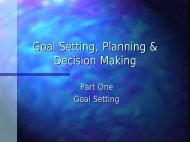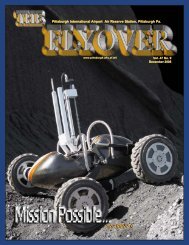Goal Setting, Planning and Decision Making
Goal Setting, Planning and Decision Making
Goal Setting, Planning and Decision Making
You also want an ePaper? Increase the reach of your titles
YUMPU automatically turns print PDFs into web optimized ePapers that Google loves.
<strong>Decision</strong>s need to be made at all levels. For example, too many decisions made<br />
at the operational level would indicate you are probably not doing enough<br />
strategic thinking, which implies a lack of planning. As a result, you are liable to<br />
be leading a reactionary life, one that is out of your control.<br />
C. Some additional techniques for decision-making.<br />
1. T-Chart. A T-Chart is an orderly, graphic representation of alternative<br />
features or points involved in a decision, so that the decision-maker can<br />
consider them in a thoughtful <strong>and</strong> coherent way. In one form, it can be a list<br />
of positive <strong>and</strong> negative attributes surrounding a particular choice. Drawing<br />
up such a chart insures that both positive <strong>and</strong> negative aspects of each<br />
direction or decision will be taken into account.<br />
For example, what are the pros <strong>and</strong> cons of deciding to buy a sport utility<br />
vehicle<br />
PRO<br />
Better visibility<br />
Safer structure<br />
Can take off road<br />
CON<br />
Higher Insurance<br />
Poorer gas mileage<br />
More expensive maintenance<br />
In another form, two possible choices are listed, with good points or<br />
arguments or effects listed for each: Suppose your company is trying to<br />
decide whether to create its own advertising or hire an agency<br />
Use Outside Agency<br />
Professional work<br />
Expertise of ideas<br />
Media connections<br />
Write Ads In House<br />
Faster product<br />
Better knowledge of product<br />
Use same ad in flyers<br />
Another technique similar to this is the PMI technique discussed earlier it is<br />
different in that “interesting” ideas are included besides the pro & con<br />
approach.<br />
2. Buriden’s Ass. This method of decision making is used when two or<br />
more equally attractive alternatives are faced. (This is from an old fable about<br />
an ass placed between two equally nice bales of hay. The ass could not<br />
decide which bale to turn to because they were both so attractive, <strong>and</strong> so it<br />
starved to death.) The method is simply to list all of the negative points or<br />
draw backs about each decision. That is, when two or more alternatives<br />
seem very desirable, we become blinded to any drawbacks. The Buriden’s<br />
Ass method simply focuses on the drawbacks.<br />
43
















